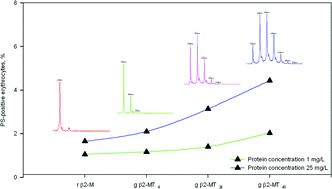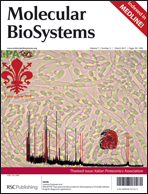The exposure of the aminophospholipid phosphatidylserine on the external leaflet of red blood cell plasma membrane can have several pathophysiological consequences with particular regard to the processes of cell phagocytosis, haemostasis and cell–cell interaction. A significant increase in phosphatidylserine-exposing erythrocytes has been reported in chronic haemodialysis patients and found to be strongly influenced by the uraemic milieu. To identify uraemic compound(s) enhancing phosphatidylserine externalization in erythrocytes, we fractionated by chromatographic methods the ultrafiltrate obtained during dialysis, and examined by flow cytometry the effect of the resulting fractions on phosphatidylserine exposure in human red cells. Chromatographic procedures disclosed a homogeneous fraction able to increase erythrocyte phosphatidylserine exposure. The inducer of such externalization was identified by monodimensional gel electrophoresis and mass spectrometry investigations as beta2-microglobulin. To confirm the beta2-microglobulin effect and to examine the influence of protein glycation (as it occurs in uraemia) on phosphatidylserine erythrocyte exposure, erythrocytes from normal subjects were incubated with recombinant beta2-microglobulin (showing no glycation sites at mass analysis), commercial beta2-microglobulin (8 glycation sites), or with in vitro glycated recombinant beta2-microglobulin (showing multiple glycation sites). Elevated concentrations of beta2-microglobulin (corresponding to plasma levels reached in dialysis patients) increased slightly but significantly the protein's ability to externalize phosphatidylserine on human erythrocytes. Such an effect was markedly enhanced by glycated forms of the protein. Beta2-microglobulin is recognized as a surrogate marker of middle-molecule uraemic toxins and represents a key component of dialysis-associated amyloidosis. Our study adds further evidence to the potential pathophysiologic consequences of beta2-microglobulin accumulation in chronic uraemic patients.

You have access to this article
 Please wait while we load your content...
Something went wrong. Try again?
Please wait while we load your content...
Something went wrong. Try again?


 Please wait while we load your content...
Please wait while we load your content...